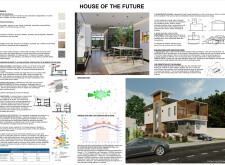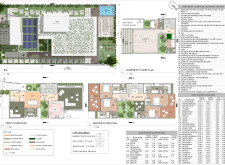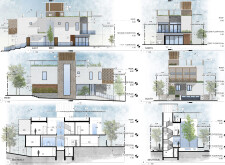5 key facts about this project
## Overview
Located in Dubai, the House of the Future offers a forward-looking approach to sustainable architectural design, addressing the region's unique climatic challenges. The intent of the design is to enhance living conditions while minimizing environmental impact through the use of environmentally conscious materials and technologies. The project incorporates traditional architectural elements alongside contemporary design strategies, reflecting a synthesis of cultural heritage and modern requirements.
## Material Expression
### Interior and Exterior Material Choices
The interior spaces incorporate renewable wool panels and low-VOC paints, enhancing insulation and maintaining indoor air quality. On the exterior, lime plaster, locally sourced coral stone, and salvaged wood siding are utilized, combining aesthetic appeal with sustainability. These materials were chosen for their thermal efficiency, durability, and minimal environmental footprint, reinforcing the overall commitment to eco-friendly construction.
## Climatic Response
### Site Orientation and Ventilation
The structure's orientation is strategically designed to maximize natural light and ventilation, with longer façades facing east and west to optimize passive solar heating while reducing heat gain. The integration of wind catchers and modern Mashrabiyas facilitates natural airflow while ensuring privacy, supported by clerestory windows that enhance cross-ventilation.
### Water and Energy Management
Innovative water management systems, including rainwater harvesting and greywater recycling, are integrated to enhance water conservation. Additionally, solar panels provide renewable energy, contributing to self-sufficiency in electricity generation. The design also features evaporative cooling techniques and efficient insulation to maintain comfortable internal conditions while minimizing energy consumption, addressing the high temperature fluctuations typical of Dubai’s climate.





















































